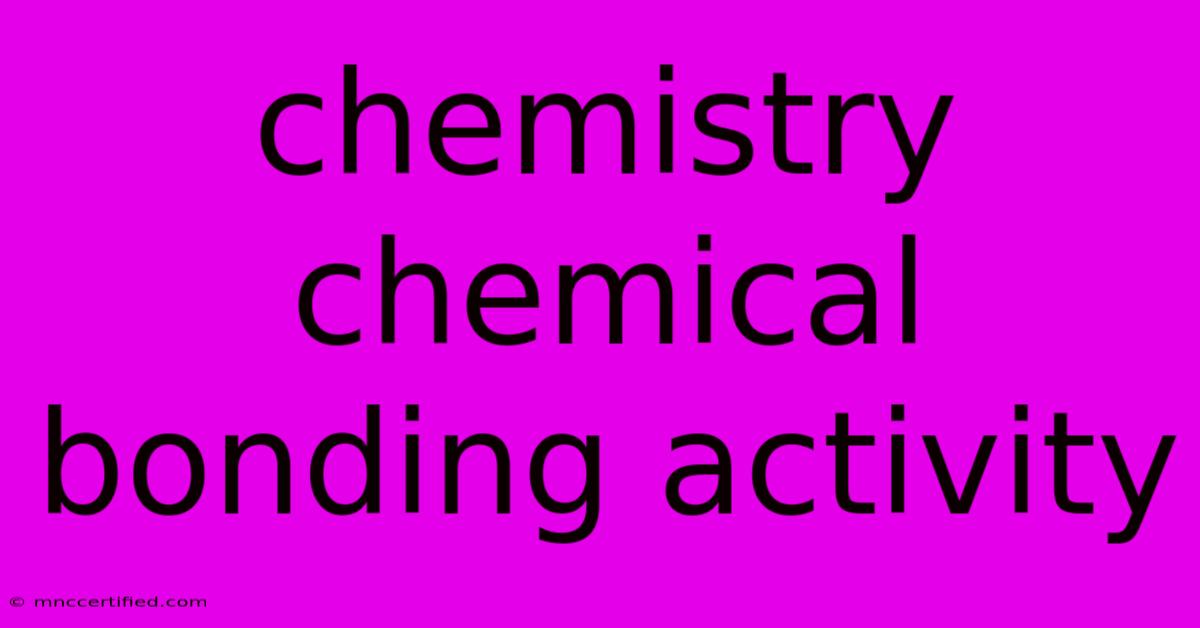Chemistry Chemical Bonding Activity

Table of Contents
Delving into the World of Chemical Bonding: A Hands-on Activity
Chemistry is all about the interactions between atoms and molecules. One of the most fundamental concepts in chemistry is chemical bonding, the force that holds atoms together to form molecules and compounds. Understanding chemical bonding is crucial for comprehending the properties and reactions of all matter.
This article will guide you through a fun and engaging activity that will help you visualize and understand the principles of chemical bonding.
The Power of Attraction: Understanding Chemical Bonding
Before diving into the activity, let's briefly review the different types of chemical bonding:
-
Ionic Bonding: This occurs when atoms gain or lose electrons to achieve a stable octet configuration. This transfer of electrons results in the formation of positively charged ions (cations) and negatively charged ions (anions) that are attracted to each other due to electrostatic forces. Think of salt (NaCl) as a classic example!
-
Covalent Bonding: Here, atoms share electrons to achieve a stable electron configuration. This sharing creates a strong attractive force between the atoms, holding them together. Water (H₂O) is a prime example of a molecule formed by covalent bonds.
-
Metallic Bonding: This type of bonding occurs in metals where electrons are delocalized and shared across the entire metal lattice. This free movement of electrons accounts for the excellent electrical conductivity and malleability of metals.
Hands-on Chemical Bonding Activity
Materials You'll Need:
- Styrofoam balls (different sizes and colors to represent different atoms)
- Toothpicks (to represent bonds)
- Markers (to label atoms and bonds)
- A table or flat surface
Instructions:
- Choose your atoms: Select styrofoam balls of different sizes and colors to represent various atoms (e.g., hydrogen, oxygen, carbon). Use markers to label the balls with the corresponding atomic symbols (H, O, C).
- Representing Bonds: Use toothpicks to connect the styrofoam balls, representing the chemical bonds between atoms. For ionic bonds, use a single toothpick, while for covalent bonds, use two or three toothpicks depending on the number of shared electrons.
- Build your molecules: Start by creating simple molecules like water (H₂O), carbon dioxide (CO₂), or methane (CH₄). You can even build more complex structures like glucose (C₆H₁₂O₆) or ethanol (C₂H₅OH).
- Label your bonds: Use markers to label each bond as ionic or covalent based on the type of bond you represented with toothpicks.
- Explore the properties: Once you have built your molecules, discuss their properties and how they relate to the type of chemical bonding involved. For example, water is a liquid at room temperature due to the strong hydrogen bonds formed between water molecules.
Benefits of this Activity:
- Visual Learning: This activity provides a tangible and visual representation of chemical bonding, making it easier for learners to grasp the concept.
- Hands-on Experience: By building the molecules themselves, students gain a better understanding of the spatial arrangement of atoms within a molecule.
- Engagement and Fun: This activity is engaging and fun, making it a great way to introduce and explore the fascinating world of chemistry.
Going Beyond the Basics
Once you have mastered the basics of building simple molecules, try the following:
- Build more complex molecules: Challenge yourself by building molecules like proteins, carbohydrates, or even DNA.
- Explore bond angles and polarity: Discuss how the arrangement of atoms in a molecule affects its bond angles and polarity, which in turn influences its properties.
- Investigate intermolecular forces: Explore how different types of intermolecular forces (e.g., hydrogen bonding, dipole-dipole interactions) affect the physical properties of molecules.
By engaging in this hands-on activity, you can deepen your understanding of the principles of chemical bonding, paving the way for a more thorough understanding of chemical reactions and the diverse world of chemistry.

Thank you for visiting our website wich cover about Chemistry Chemical Bonding Activity. We hope the information provided has been useful to you. Feel free to contact us if you have any questions or need further assistance. See you next time and dont miss to bookmark.
Featured Posts
-
Monday Picks Dolphins Rams Nhl College Basketball
Nov 12, 2024
-
Jordan Spieth Farmers Insurance Open
Nov 12, 2024
-
Clark And Sheffield Bottled In Bond
Nov 12, 2024
-
Bishop Calls For Welby Resignation Over Serial Abuse
Nov 12, 2024
-
Best Keyboard For Investment Banking
Nov 12, 2024